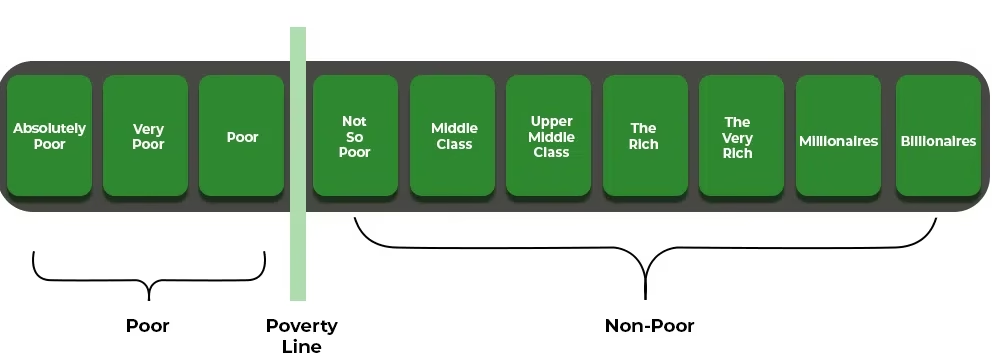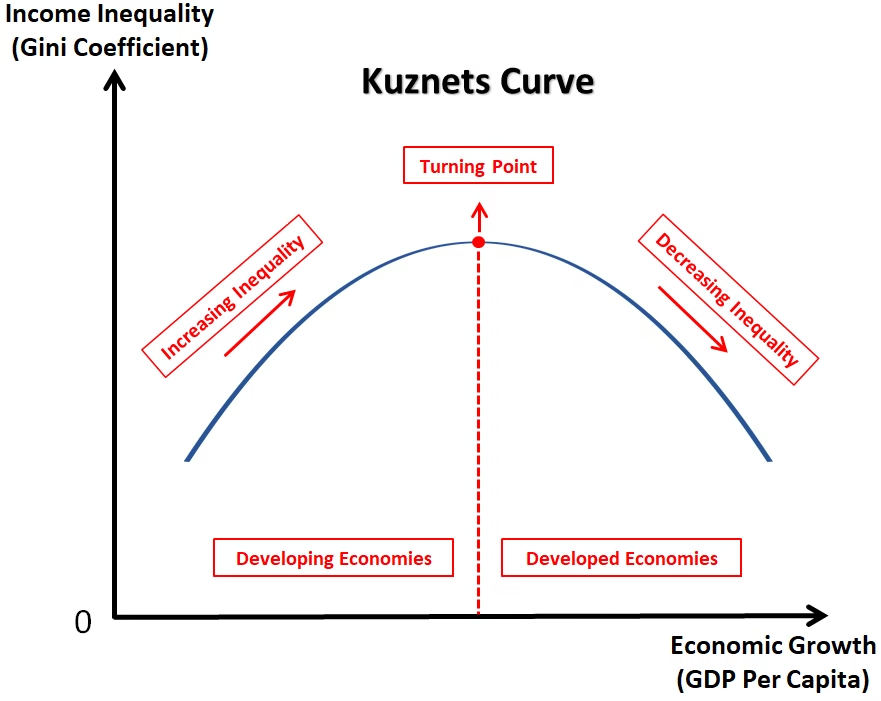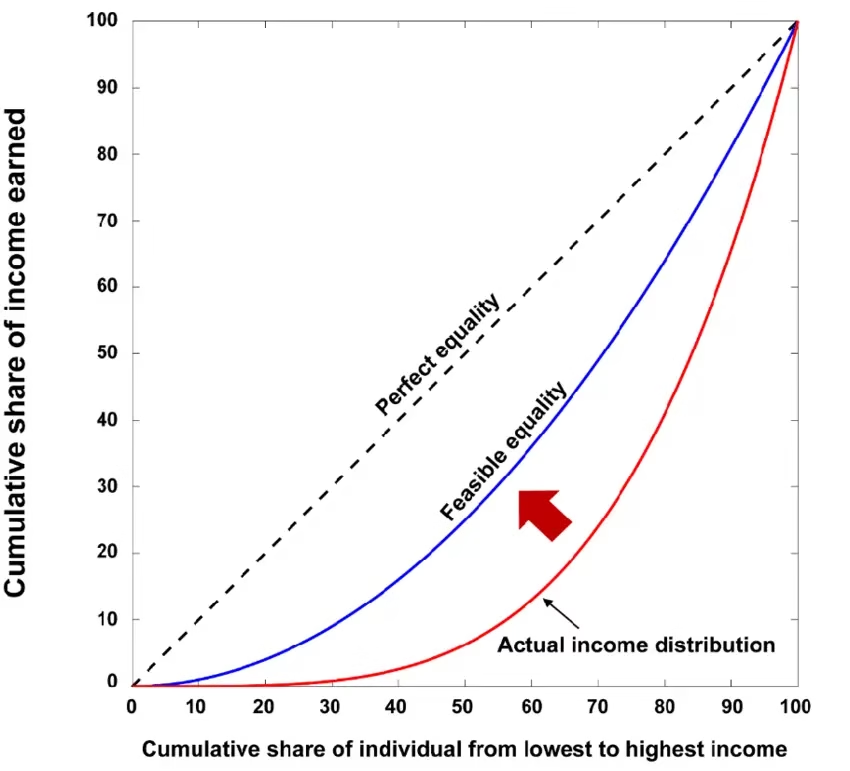Poverty and inequality along with rising unemployment are the major challenges for the Government of India, Since Independence.
What is Poverty?
Poverty is a state or situation in which a person or a group of people don’t have enough money or the basic things they need to live.
Poverty means that a person doesn’t make enough money from their job to meet their basic needs. People and families who are poor may not have a good place to live, clean water, healthy food, or medical care.
Each country can use its own set of rules to figure out how many people are poor.
“In India the generally accepted definition of poverty emphasizes minimum level of living rather than a reasonable level of living”.
In economics there are two important classification of poverty; Absolute Poverty’ and ‘Relative Poverty’.
Absolute Poverty
Absolute Poverty is the sheer deprivation or non-fulfilment of bare minimum needs of existence- of food, shelter, health or education. It is based on the absolute needs of the people and people are defined as poor when some absolute needs are not sufficiently satisfied.
Most of the developing countries are experiencing such type. An absolute poverty line is based on the cost of minimum consumption basket based on the food necessary for a recommended calorie intake.
Relative Poverty
Relative Poverty is related with high income countries, where people are poor because they cannot maintain or equivalent to others in the society. There should be differences in living standards among the people. It reflects economic distress, despair and dissension that stem from serious inequalities in income and wealth. The relative poverty line varies with the level of average income. Relative poverty is based on inequality and differences in standard of living.
Measuring Poverty
It is essential to measure poverty with its various dimensions. The measurement of poverty is needed to plan policies to check this global phenomenon.
Poverty Line
The poverty line is the minimum amount of money a person needs to meet their basic needs. It varies by country and is often revised as countries develop.
The international poverty line, which is currently $2.15 per person per day, is the threshold that determines whether someone is living in poverty.
The poverty line in India is defined as ‘the level of private consumption expenditure, which ensures a food basket that would supply the required amount of calories’. The poverty line defines a threshold income. Households earning below this threshold are considered poor. The erstwhile Planning Commission used to release the poverty measures.
Poverty is measured based on consumer expenditure surveys of the National Sample Survey Organisation.
A poor household is defined as one with an expenditure level below a specific poverty line.

India’s Poverty Line
Earlier, India used to define the poverty line based on a method defined by a task force in 1979. It was based on expenditure for buying food worth 2,400 calories in rural areas, and 2,100 calories in urban areas.
In 2011, the Suresh Tendulkar Committee defined the poverty line on the basis of monthly spending on food, education, health, electricity and transport. According to this estimate, a person who spends Rs. 27.2 in rural areas and Rs. 33.3 in urban areas a day are defined as living below the poverty line. For a family of five that spends less than Rs. 4,080 and Rs. 5,000 in rural and urban areas respectively is considered below the poverty line. This has been criticised for fixing the poverty line too low.
According to a committee headed by former Reserve Bank governor C Rangarajan, there were 363 million people, or 29.5% of India’s 1.2 billion people, who lived in poverty in 2011-12.
The Rangarajan panel considered people living on less than Rs. 32 a day in rural areas and Rs. 47 a day in urban areas as poor.
- The Expert Group (Tendulkar) had used the all-India urban poverty line basket as the reference to derive state-level rural and urban poverty. This was a departure from the earlier practice of using two separate poverty line baskets for rural and urban areas. The Expert Group (Rangarajan) reverts to the practice of having separate all-India rural and urban poverty basket lines and deriving state-level rural and urban estimates from these.
- The Expert Group (Tendulkar) had decided not to anchor the poverty line to the then available official calorie norms used in all poverty estimations since 1979 as it found a poor correlation between food consumed and nutrition outcomes. However, on a review of subsequent research, the Expert Group (Rangarajan) took a considered view that deriving the food component of the Poverty Line Basket by reference to the simultaneous satisfaction of all three nutrient -norms would be appropriate when seen in conjunction with the emphasis on a full range of policies and programmes for child-nutrition support and on public provisioning of a range of public goods and services aimed at the amelioration of the disease-environment facing the population.
- Estimates of consumption expenditure seen in the National Accounts Statistics and as inferred from the sample surveys of the National Sample Survey Organisation show a large and growing variance. The Expert Group (Rangarajan) prefers NSSO’s estimates and decides not to use the NAS estimates. This is in line with the approach taken by Expert Group (Lakdawala) and Expert Group (Tendulkar).
- The capture of spatial and temporal variation in prices in estimating the State-level and rural-urban poverty levels (given all-India rural and urban estimates) has undergone substantial refinement since 1979. The Expert Group (Rangarajan) agrees with the methodology adopted by the Expert Group (Tendulkar) in this regard. This overcomes the limitations of using fixed base-year weights by using a combination of unit values derived from successive NSSO’s Consumer Expenditure Surveys and price-relatives derived from the Consumer Price Indices.
- Public expenditure on social services has increased substantially in recent years. These expenses are not captured, by design, in the NSSO’s Consumer Expenditure Surveys and the poverty line derived from these is thus lower than the services actually consumed.
- The Expert Group (Rangarajan) is of the considered view that the deployment of criteria other than consumption expenditure in the measurement of poverty raises several issues regarding measurement and aggregation and that these render such exercises impractical. However, the Expert Group (Rangarajan) has considered an alternate view in estimating the poverty line by reference to the ability of households to save.
The discussion about different Committees make it clear that defining a poverty line in India has been a controversial issue since 1970s. The latest poverty line defined was by Rangarajan Formula. However, this report also did not assuage the critics. The new NDA Government turned down this report also.
To define the poverty line, The NDA Government had constituted a 14-member task force under NITI Aayog’s vice-chairman Arvind Panagariya to come out with recommendations for a realistic poverty line.
After one and half years work, this task force also failed to reach a consensus on poverty line. In September 2016, it suggested to the government that another panel of specialists should be asked to do this job {if defining poverty line}. Informally, this committee supported the poverty line as suggested by Tendulkar Committee.
Why defining poverty line is a controversial issue?
Most of the governments have mothballed the reports of committees and panels because this issue is not only politically sensitive but also has deeper fiscal ramifications.
If the poverty threshold is high, it may leave out many needed people; while if it is low, then it would be bad for fiscal health of the government.
There is a lack of consensus among states too. We note that some states such as Odisha and West Bengal supported the Tendulkar Poverty Line while others such as Delhi, Jharkhand, and Mizoram etc. supported Rangarajan Line.
Thus, no one, including NITI Aayog wants to bell the cat when it comes to count number of poor in the country.
Causes of Poverty in India
Increase rate of rising population
In the last 45 years, the population has increased at the whopping rate of 2.2% per annum. An average of approx. 17 million people are added every year to the population which raises the demand for consumption goods considerably.
Less productivity in agriculture
In agriculture, the productivity level is very low due to subdivided and fragmented holdings, lack of capital, use of traditional methods of cultivation, illiteracy etc. The very reason for poverty in the country is this factor only.
Less utilization of resources
Underemployment and veiled unemployment of human resources and less utilization of resources have resulted in low production in the agricultural sector. This brought a downfall in their standard of living.
A short rate of economic development
In India, the rate of economic development is very low what is required for a good level. Therefore, there persists a gap between the level of availability and requirements of goods and services. The net result is poverty.
Increasing price rise
Poor is becoming poorer because of continuous and steep price rise. It has benefited a few people in the society and the persons in lower income group find it difficult to get their minimum needs.
One of the main causes of poverty is the continuous expanding army of unemployed in our country. The job seeker is increasing in number at a higher rate than the expansion in employment opportunities.
Shortage of capital and able entrepreneurship
The much-required capital and sustainable entrepreneurship play a very important role in accelerating the growth. But these are in short supply making it difficult to increase production significantly.
Social factors
Our country’s social set up is very much backward with the rest of the world and not at all beneficial for faster development. The caste system, inheritance law, rigid traditions and customs are putting hindrances in the way of faster development and have aggravated the problem of poverty.
Unequal distribution of income
If you simply increase the production or do a checking on population cannot help poverty in our country. We need to understand that inequality in the distribution of income and concentration of wealth should be checked. The government can reduce inequality of income and check the concentration of wealth by pursuing suitable monetary and price policies.
The problem of distribution
The distribution channel should be robust in order to remove poverty. Mass consumption of goods and food grains etc. should be distributed first among the poor population. Present public distribution system must be re-organised and extended to rural and semi-urban areas of the country.
Regional poverty
India is divided by the inappropriate proportion of poor in some states, like Nagaland, Orissa, Bihar, Nagaland, etc. is greater than the other states. The administration should offer special amenities and discounts to attract private capital investment to backward regions.
Provision for minimum requirements of the poor
The government should take care of the minimum requirements, like drinking water, primary medical care, and primary education etc. of the poor. The public segment should make generous expenditure on the poor to provide at least minutest requirements.
Global Multidimensional Poverty Index
Global Hunger Index
Poverty debates in India
Poverty and Inequality
Rural Poverty
How rural-urban migration contributing to urban poverty?
Inequality
While the concept of poverty is rooted in the “lack of access” or “a low level of access” to food, nutrition, shelter, education and other services. Inequality is related to “unequal access” or “different degrees of access” of different individuals or groups of individuals to opportunities, services and benefits. Inequality is, thus, a more general concept than poverty. It looks at the relative levels of access of different groups to development opportunities and benefits.
Inequality in India
India is shining for only a select few. The impressive economic growth of our country has brought smiles on the faces of the rich and the powerful even as the rest suffer in distress and drudgery. This was revealed by the Human Development Report, 2011 (HDR) released by Planning Commission. The report highlights the skewed income and wealth distribution in India and the widening gap between the rich and the poor. According to HDR 2011, inequality in India for the period 2000-11 in terms of the income Gini coefficient was 36.8.
Types of Inequality
There are three important types of inequality exist in India, namely inequality in income and consumption, inequality in assets and regional inequality. These three forms of inequality are interrelated and mutually reinforcing. The Government of India has been concerned about rising inequalities and uneven distribution of the benefits of growth.
Inequality in Income and Consumption
Consumer expenditure of households is a good proxy for income, at least in the lower classes. A study of inequalities in levels of consumption will by itself be useful in an economy where agriculture, the unorganised sector, payment of wages in kind and the non-monetised sector still play an important role.
If we turn to levels of inequality in consumption, the household consumer expenditure surveys of the NSSO provide the levels of consumption of expenditure in the population by Monthly Per capita Consumer Expenditure (MPCE) classes. The Average MPCE of the rural people in India is only Rs.1054 and in Urban it is Rs.1984. The inequality situation is worse in urban areas than in rural areas. Inequality in consumption is declining, albeit slowly, in rural areas according to all measures of inequality. On the other hand, urban inequality shows no sign of any decline.
Inequality in Assets
Incomes are derived from two main sources. Namely, assets like land, cattle, shares and labour etc. In India a few own a large chunk of income-earning assets therefore the distribution of assets is extremely unequal. Asset accumulation is minimal among the agricultural labour households in rural areas and casual labour households in urban areas. But the asset distribution is even more unequal in the urban than in the rural areas.
Regional Inequality
Third important type of inequality that India faces is the regional inequality. Some states are economically and socially advanced while others are backward. Even within each state some regions are more developed while others are primitive. The co-existence of relatively developed and economically depressed states and even regions within each state is known as regional inequality. The existence of regional inequality creates social, economic and political issues. The regional inequality is so prominent in India in the case of HDI Value, growth of the economy, poverty, unemployment, education, health, monthly per capita expenditure, rural- urban divide etc.
Causes of regional inequality
- Historical Factors
- Geographical factors
- Infrastructure
- Decline in Public Investment
Kuznets Curve
Kuznets Curve is used to demonstrate the hypothesis that economic growth initially leads to greater inequality, followed later by the reduction of inequality. The idea was first proposed by American economist Simon Kuznets.
As economic growth comes from the creation of better products, it usually boosts the income of workers and investors who participate in the first wave of innovation. The industrialisation of an agrarian economy is a common example. This inequality, however, tends to be temporary as workers and investors who were initially left behind soon catch up by helping offer either the same or better products. This improves their incomes.

Kuznets Environmental Curve
The environmental Kuznets curve suggests that economic development initially leads to a deterioration in the environment, but after a certain level of economic growth, a society begins to improve its relationship with the environment and levels of environmental degradation reduces.
From a very simplistic viewpoint, it can suggest that economic growth is good for the environment.

Lorentz Curve
The distribution of Income in an economy is represented by a Lorenz Curve and the degree of income inequality is measured through the Gini Coefficient. One of the five major and common macroeconomic goals of a government is the equitable (fair) distribution of income.
The Lorenz Curve (the actual distribution of income curve), a graphical distribution of wealth developed by Max Lorenz in 1906, shows the proportion of income earned by any given percentage of the population. The line at the 45º angle shows perfectly equal income distribution, while the other line shows the actual distribution of income. The further away from the diagonal, the more unequal the size of distribution of income.
In the below example, the Lorenz Curve, which represents the actual distribution of income in a country, shows how the poorest 20% of the population only earn 5% of the national income in this population. While in a case of perfect equality, the poorest 20% of the population would earn 20% of the income. The more bowed out a Lorenz Curve, the greater is the inequality of income in the country.


The Gini Coefficient
The Gini Coefficient, which is derived from the Lorenz Curve, can be used as an indicator of economic development in a country. The Gini Coefficient measures the degree of income equality in a population.
The Gini Coefficient is equal to the area between the actual income distribution curve and the line of perfect income equality, scaled to a number between 0 and 100. The Gini coefficient is the Gini index expressed as a number between 0 and 1.
The Gini Coefficient can vary from 0 (perfect equality) to 1 (perfect inequality). A Gini Coefficient of zero means that everyone has the same income, while a Coefficient of 1 represent a single individual receiving all the income.





